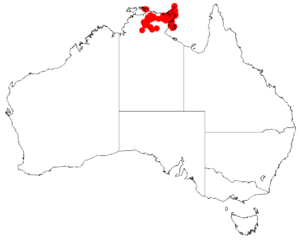Acacia yirrkallensis facts for kids
Quick facts for kids Acacia yirrkallensis |
|
|---|---|
| Conservation status | |
|
LC (TPWCA)
|
|
| Scientific classification | |
| Genus: |
Acacia
|
| Species: |
yirrkallensis
|
 |
|
| Occurrence data from AVH | |
| Synonyms | |
|
Racosperma yirrkallense (Specht) Pedley |
|
Acacia yirrkallensis is a type of shrub that belongs to the Acacia family, also known as wattles. It grows naturally in the northern part of Australia, specifically in the Northern Territory.
What it Looks Like
Acacia yirrkallensis is a shrub that can grow from 1 to 2 meters (about 3 to 6.5 feet) tall. It can stand upright or spread out low to the ground. Its branches often start close to the ground.
The bark of this plant is smooth and can be dark grey or dark brown. Its younger branches are smooth and have a brown, reddish-brown, or yellowish color. These branches also have small ridges with tiny bumps that feel sticky, like resin.
The leaves, called phyllodes, are tough and shaped like a narrow oval. They are usually 1.5 to 4.5 cm long and 1.4 to 5.2 mm wide. You can see tiny pores (stomata) on them, along with one or more clear veins. Other smaller veins run parallel but are harder to see.
This acacia has small, round, yellow flower heads, each about 3 to 4.5 mm across. Each head contains 10 to 13 tiny flowers. These flowers have five parts and a smooth, almost separate outer layer called a calyx. The inner part, called the corolla, is also smooth.
After flowering, the plant produces flat, woody seed pods. These pods are straight-sided and shaped like a spoon, narrower at the base. They are 2 to 5 cm long and 4 to 9 mm wide. The pods have slanted lines on them, and their edges are easy to see, as are the divisions between the seeds. The seeds inside are brown to dark brown and about 2.5 to 3.5 mm long. Each seed has a special top-shaped attachment called an aril.
This plant usually flowers from June to January. Its fruits, or pods, develop from February to October.
Where it Lives
Acacia yirrkallensis typically grows in eucalypt forests and woodlands. It prefers grey sandy soils, and areas with laterite and bauxite. You can also find it on stony sandstone ridges and in gorges.
Where it is Found
This shrub is found in several natural areas, or Bioregions, in the Northern Territory. These include the Arnhem Coast, Arnhem Plateau, Central Arnhem, Gulf Fall and Uplands, Pine Creek, and Tiwi Cobourg regions.

